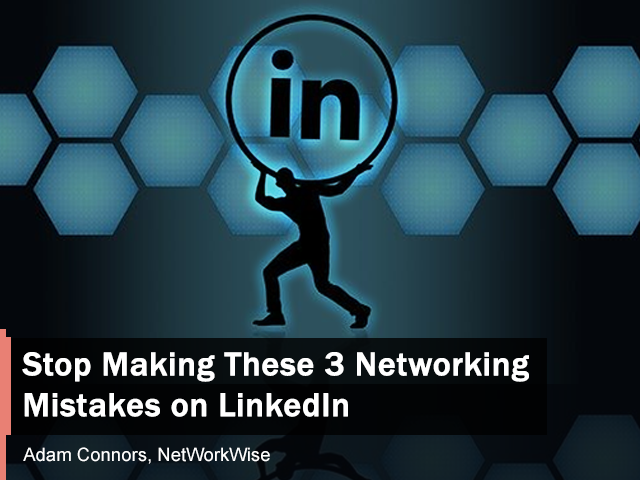LinkedIn is a beneficial tool for building your networks. When used properly it can be advantageous in growing your professional relationships and opens you up to opportunities.
But if you’re taking advantage of it to simply raise the number of connections listed with your profile, you’re making a mistake and should evaluate your view of what networking really is.
Establishing professional contacts on LinkedIn can advance your career and improve your spheres of influence, but many make common errors when doing so (and may not even realize it). Here are three mistakes you need to stop making when networking on LinkedIn—and what you can do instead:
Mistake #1: STOP Using This Mindset
You may think building a long list of contact names on LinkedIn is networking. But in fact, it’s the opposite! On the surface it might seem you have several connections and access to numerous resources, but if there’s no real value in your relationships and you’re just adding people for no particular purpose, you won’t get very far. In fact, this is typically a way to fail at networking. If you want to only develop a large number of meaningless contacts, then just keep doing this!
USE THIS Instead
You need to approach LinkedIn with the proper networking mindset. You will get out of it what you put into it! Networking is about fostering relationships and building foundations for deeper connections. It’s about nurturing your contacts and creating something mutually beneficial that both parties will find valuable. Overall, it isn’t about what others can do for you, it’s about what you can do for them.
“Networking is not necessarily a numbers game. The idea is not to see how many people you can meet; the idea is to compile a list of people you can count on.”
Harvey Mackay
There really is truth to the saying that it’s not about how many people you can COUNT, it’s more about those you can COUNT ON. As said by Al Capone: “Be careful who you call your friends. It’s better to have four quarters than 100 pennies.” You’re much better off surrounding yourself with a small number of influential individuals who have an impact than a large number of people with whom you don’t necessarily share a bond or commonality.
Mistake #2: STOP Posting This
I’ve noticed many posts on LinkedIn, especially recently, that are doing the opposite of what it truly means to network. Instead, they encourage people to connect with each other just for the sake of making a connection. I’m referring to the ones that go something like this:
How to network in 3 easy steps!
- Click Like on this post
- Comment and say I’m Open to Connect
- Send me an invite and I will connect with you
Follow the instructions above and watch your number of connections grow.
Guess what, this is the antithesis of networking! It goes against every idea of how to build foundations for significant relationships. And yet these kinds of posts typically get a lot of traction. But what are the benefits here? How can you find value in this if you’re just arbitrarily connecting with others?
What these posts are really doing is putting you in touch with random people for no real reason. You can think of these threads more like chain letters that enable you to simply link with others on LinkedIn, but without creating any foundation for something meaningful. If you want to cultivate robust and healthy networks that will enable your personal and professional success, this is NOT how to do it.
POST THIS Instead
There are ways to develop rapport and promote value through your LinkedIn posts that do inspire a real connection. For instance, I recently published an update that said this:
I’d like to thank and bring to light some people that have done an excellent job of continuously posting meaningful content that’s positive and informative, especially during these times. Please comment and tag someone in your networks who is also delivering value we could all benefit from!
When I published it, I tagged several people from my spheres of influence that are consistently encouraging others through their positive posts, and they in turn did the same. It garnered excellent results and feedback (you can view the reactions here: https://www.linkedin.com/posts/greatpeopleknowgreatpeople_thefiveminutefavor-value-thankfulthursday-activity-6659064376806424576-dxLL/)
Through this post I provided worth and something of value—and people found each other and connected. This helped me facilitate introductions through my networks based on meaning, and not just randomly bringing two individuals together without any purpose.
There are other types of posts which incorporate providing a specific value and endorse connectivity. For example, the concept of Self-Promotion Sunday (#SPS) encourages people to promote themselves on a thread about what they do and how they do it, and you invite others to connect if they’re interested in learning more about your product or service.
There’s also Work in Progress Wednesday (#WIPWednesday) which is a similar concept where you share what you’re currently working on and forge connections with those who want to find out more details. While these may sound similar to the bad example I mentioned earlier, they’re different in the way you engage directly with an audience of peers and clients and people who want to learn more about you and who do add value to your networks.
Mistake #3: STOP Sending This Invitation
Another way to forge meaningless LinkedIn connections from the start is by sending an invitation with the standard “I’d like to connect with you” message. Please do not do this!
I frequently receive these invites that have no real thought behind them. This demonstrates you are looking to build up your contact numbers, but not interested in the true value of networking. There’s a science and art behind relationship-building, and when you understand this you’re able to create worthy and mutually beneficial connections.
SEND THIS Instead
Always customize your invite but be brief while doing so—you only have 300 characters! Say who you are and anything you have in common such as a shared group or mutual contact. Indicate why you’re reaching out and goals you may have for generating a connection. Extend your value proposition and how the other person may benefit by establishing a relationship. For example:
We’re both members of ABC Group and I’ve enjoyed your thought-provoking discussions. I read your profile and noticed we’re in the same industry! I’d like to connect as I’m currently working on a project you may benefit from. Thanks!
It’s human nature to favor helping those you consider friends over more casual contacts, and you’re more apt to collaborate more closely with those you know, like & trust. Avoid making these mistakes on LinkedIn and you’ll establish connections that will enhance your networks and also your career. Do not utilize it to simply grow your number of contacts! Use it wisely and you’ll find it to be another beneficial tool in your networking tool box.









